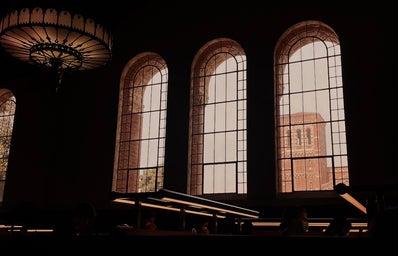The Aestheticism movement began in the late 19th century (c. 1860-1899) and rejected many of the ideals at the time and the ideals of art movements before it. Aestheticism was the idea of “art for art’s sake” (the English of the phrase “l’art pour l’art” coined by Victor Cousin in 1818). Art during this movement was not meant to have any other purpose than beauty; it had no political, emotional, or social commentary. The Aestheticism movement was meant to rebel against the major industrialism present at the time by producing goods that had no other purpose than to be beautiful. It also introduced the idea that art was more than paintings and plays and should be spread to things people use in their everyday lives, like furniture and interior design.
While some people believe that Aestheticism preaches immorality, that’s not true; it frees art from morals and advocates art for the sake of art.
~ Giulia Vilardi
The foundations for the Aestheticism movement were laid by the German philosopher Immaneul Kant who talked about aesthetics in his work Critiques of Judgements, which lays out four features of an ‘aesthetic judgement’: how we judge something as beautiful. These guidelines were used by other German artists and philosophers, like Goethe, before they began to travel outside Germany.
Aestheticism made its way into England through the stylings of Samuel Taylor Coleridge and Thomas Carlyle. At that time, the purpose of writing was to be quick and to the point, especially in historical works. However, in Carlyle’s work The French Revolution (published 1837); which is a three part historical account of the French Revolution, Carlyle used colourful language and metaphors, making the sentences unclear and the meaning hard to find. This writing style, filled with metaphor and rhetorical language, set the stage for the later works in the Aesthetic period. The Aestheticism movement was also influenced by the artwork of the Pre-Raphaelite Brotherhood. The Pre-Raphaelite Brotherhood formed in 1848 with the goal to bring back the beauty of Renaissance art to British art. The early doctrine of the Pre-Raphaelite Brotherhood emphasized the importance of allowing each artist to have their own unique style. They had a focus on nature, creating emotion in their art, and above all else producing high quality, beautiful paintings. Part of this movement influenced the “decorative arts” by creating companies that produced high class and visually pleasing decorations (like tapestries and furniture) sold at a lower price making it available to a wider bunch of consumers. This also influenced artists like Phoebe Traquair (who made all kinds of art) and Aubrey Beardsley (who was an illustrator), both of whom contributed to the Arts and Crafts movement, a movement that sought to make things that were both useful and beautiful. The Arts and Crafts movement was tied closely to Industrialism, with the British wishing to distance themselves from it and the Americans seeking to embrace the new age of machinery. However, the ideal of creating beautiful art was seen in both England and America and inspired the Aesthetic movement.
Aestheticism also travelled to France through the philosophy of Victor Cousin. He believed that art from the Aestheticism movement represented the ideal and that the ideal is beautiful and invokes the senses. A good painting must make you have feelings. Theophile Gautier also helped Aestheticism expand into France. Gautier believed that as an artist you should be concerned about perfecting your form, not about imbuing art with meaning. Gautier expressed these views in his book Albertus and Mademoiselle de Maupin, which caused controversy in the art world. He also developed a type of poetry called “transposing art” where he would write about how certain art pieces made him feel.
Another artist at the front of the Aestheticism movement was Oscar Wilde. Wilde was very famous in his time and known for being flamboyant and extremely witty. After he finished school most of Wilde’s works followed the pattern of the Aesthetics movement, with flowy, descriptive language filled with metaphors and hidden meanings. He was inspired by John Ruskin and Walter Pater, who both supported that life should be lived with “aesthetic intensity”. Because of this Wilde wore velvet jackets and knee stockings, as well as decorated his rooms with objets d’art, creating an “aesthetic pose”. Wilde also went to America and Canada in 1882 and lectured in universities for a year on aestheticism and love for the arts. These themes were most present in one of his final works and only novel The Picture of Dorian Gray. At the time, this book was labelled immoral for its insistence on pursuing a life full of sensations, as was the Aestheticism movement as a whole.
The Peacock Room, which was a mix of painting and interior design, by James Whistler is a true homage to the Aestheticism movement, with dark blues and bright golds that had no other purpose than to make the room beautiful.
While the Aestheticism movement was short-lived compared to other art movements, it had a lasting effect on art. Since Oscar Wilde was so tied to the Aestheticism movement, when he was arrested due to “gross indecency” (basically the legal reason to arrest someone for being homosexual during that time) many followers believed that the movement supported immorality or sexual promiscuity and turned away. The Aestheticism movement led to the even shorter-lived Decadent movement. The Aestheticism movement is what separated art from the need to have a socio-political, moral, or historical meaning. This lack of historical meaning transferred to one of the more famous art movements: the Abstract Expressionism movement (which produced artists like Franz Cline, Norman Lewis, and Janet Sorbel who was an inspiration for Jackson Pollock). The idea that an artist’s expression is the most important part of the art carried through a multitude of movements and is still seen today in Contemporary Art.
Aestheticism is one of my favourite art movements for the fact that it detached art from the necessity of a meaning, allowing for art to be created just for beauty — though it is important to remember that the artists of the Aestheticism movement had the privilege to be able to separate art from meaning, something not all artists had. While some people believe that Aestheticism preaches immorality, that’s not true; it frees art from morals and advocates art for the sake of art.
https://www.theartstory.org/movement/pre-raphaelites/history-and-concepts/
https://www.britannica.com/biography/Theophile-Gautier
https://www.britannica.com/art/Aestheticism
https://www.cmgww.com/historic/wilde/career/
https://www.britannica.com/biography/Oscar-Wilde
https://www.theartstory.org/movement/aesthetic-art/ https://www.theartstory.org/movement/arts-and-crafts/


